Pomodoro Time Forecasting
Many have discovered the power of focused effort on work, allowing you do get more done in less time. With the Pomodoro Technique, you can even get 40 hours of work compressed down into 16.7 hours, which is a direct result of working smarter, not harder.
The Pomodoro Technique is time management method and philosophy for working with more focus on a series of short work sprints.
Here's how it works
- Choose A Task You Want To Focus on Getting Done.
- Set Timer to 25 minutes.
- Work on the task until the timer is complete
- Take a 5-minute break.
- Every four sessions take a 15-minute break.
Pomodoro Time Forecasting
The Pomodoro Time Forecasting system is a way to pre-commit chunks of time towards focused effort with Pomodoros for work or some other initiative. At the end or start of the week, you estimate how much free time you have per day and at the end of the week you compare how much Pomodoros you have completed with the total amount of time you estimated. Having this spreadsheet is a way towards building the habit of doing Pomodoros on a consistent basis and holding yourself accountable for starting and finishing work.
Get a Copy of the Pomodoro Time Forecasting Spreadsheet
Motivation
I want to make it a habit to consistently allocate time to invest back into my personal development and career growth.
The goal was to change my habits after work from winding down and falling into the entertainment trap, towards consciously building myself and producing when most people would be consuming.
I did not want my growth to be tied to the particular job I was working for and want to be capable of using my scarce time outside of work in highly abundant ways.
Pomodoro at work?
I don't use Pomodoro at my full-time job because the situation isn't that optimal for it, you can use your awareness and situation to see if it's right for you.
My personal rule is that if I'm distracted for more than five minutes, I have to cancel my Pomodoro, and there are plenty of opportunities for my Pomodoro to be canceled at work.
Experience With Pomodoro
In a way, I think of my out of work Pomodoros as practice, training my focus, and my job as gameday where I put my focus to free use without the Pomodoro aid, reducing the co-dependency on the tool for focus. I have been using the Pomodoro Technique for over six years to amazing results and have been using the Forecasting System for around three years to help me stay on track. My focus has become razor sharp, and I feel less urges to multi-task.
Recommended Pomodoro Tools
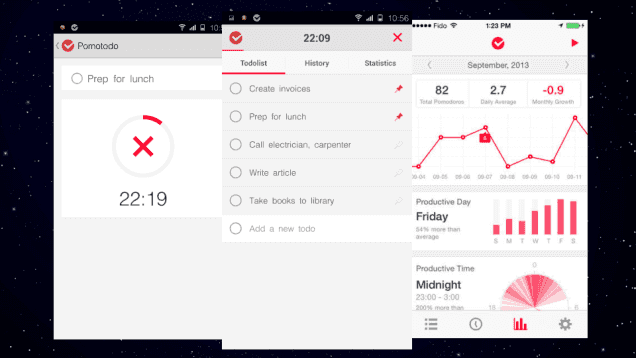
Pomotodo
Pomotodo is a simple app based on Pomodoro Technique and Getting Things Done (GTD). It is supported across all major devices and has the cleanest design out of most apps I've used.
Focus Keeper Pro
Focus Keeper Pro is a Pomodoro timer for iOS.
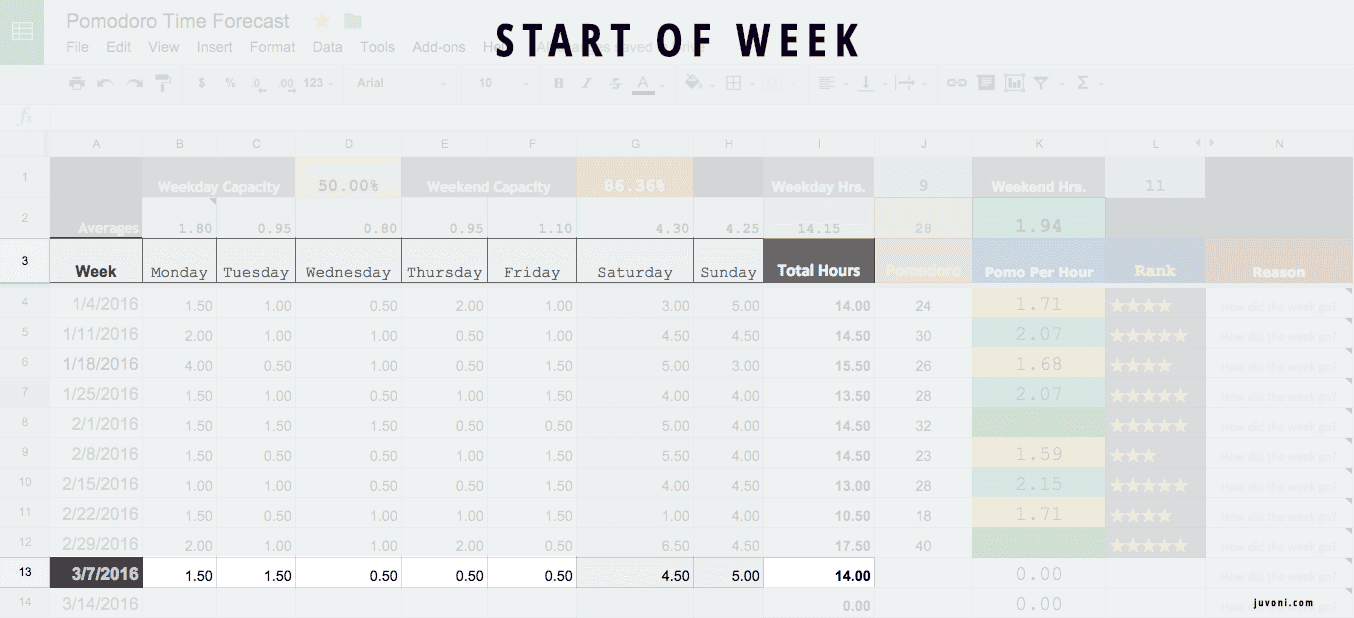
Start of The Week
Every Sunday, I look at my calendar for events and other obligations, and I'll estimate how much free time I expect to have outside of those things. What's important is understand that it's ok not to be 100% accurate with your forecast and to allow for some added flexibility in the amount of time you want to commit to investing. For this particular week I estimated:
Mon 1.5hrs, Tues: 1.5hrs, Weds: 1.5hrs, Thurs: 0.5hrs, Fri: 0.5hrs
Sat: 4.5hrs, Sun: 5hrs
You can improve your ability to estimate days by putting some structure around your days and improving your ability to say no to things that are not aligned with your priorities or things you don't enjoy.
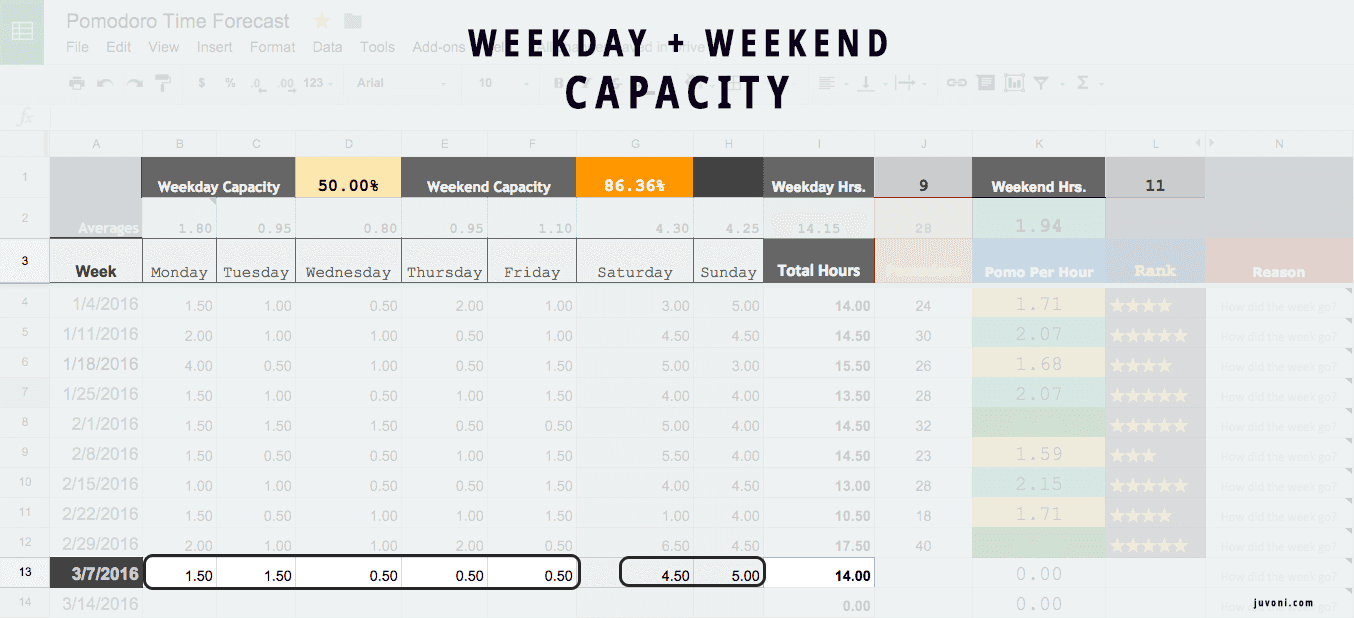
Weekday + Weekend Capacity
At the top of the spreadsheet, I enter in my goal weekday and weekend hours, which are the total hours that would be ideal to invest and forecast towards consistently.
The sum of your forecasted weekday entries and the sum of your weekend entries divided by the total weekday and weekend hours gives you your weekday and weekend capacity.
The weekday and weekend capacity will help you know how much work you can take on or what kinds of work.
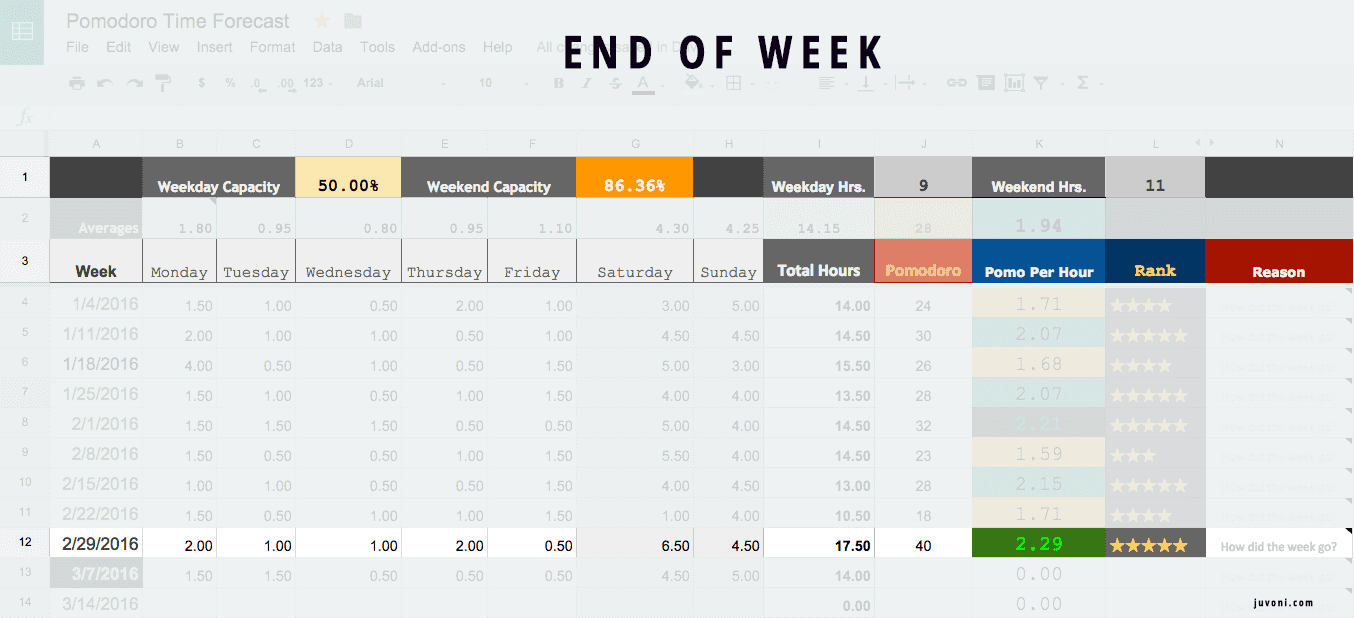
End Of The Week
When the end of the week comes, enter your total number of Pomodoro for the week. Your Pomodoro Per Hour Rate will be calculated and color coded.
Two Pomodoro sessions plus both 5-minute breaks = 1 hour.
The goal is to get a Pomodoro per hour rate of 2 or above.
A rate of 2 would mean that you utilized all of the Pomodoro that could have been done within the total hours you committed to investing for the week.
Having above 2.2 would mean that you worked more time than you originally committed. If you consistently get in this range, you should consider adjusting your forecasts to include more time.
Below 1.8 means that you worked less than you committed to working towards. If you find yourself in the red a lot, below 1.4, you should document the reasons why you were unable to invest the time you wanted to and fix it or adjust your future estimates for a lower amount of time.
There is also a 5-star rank column which is may be easier to interpret. It ranks how close you were to your total hour forecast.
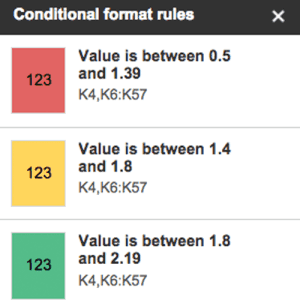
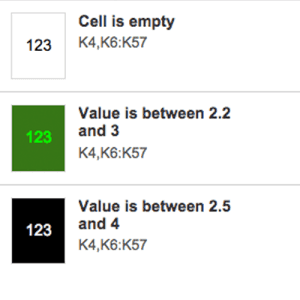
Colors to Indicate the level of success of your score

Averages
Near the top of the spreadsheet, you'll find daily averages, an average of your total hours estimated, as well as your Pomodoro and Pomodoro-per-hour average. The daily averages can be helpful in figuring out your busy and light days so you can make more accurate time estimates.
The Pomodoro average can let you know how many units of work you get done on average.
The Pomodoro-per-hour average will let you know how effective you are in getting work done within the amount of time you committed to investing over time.
Complete View
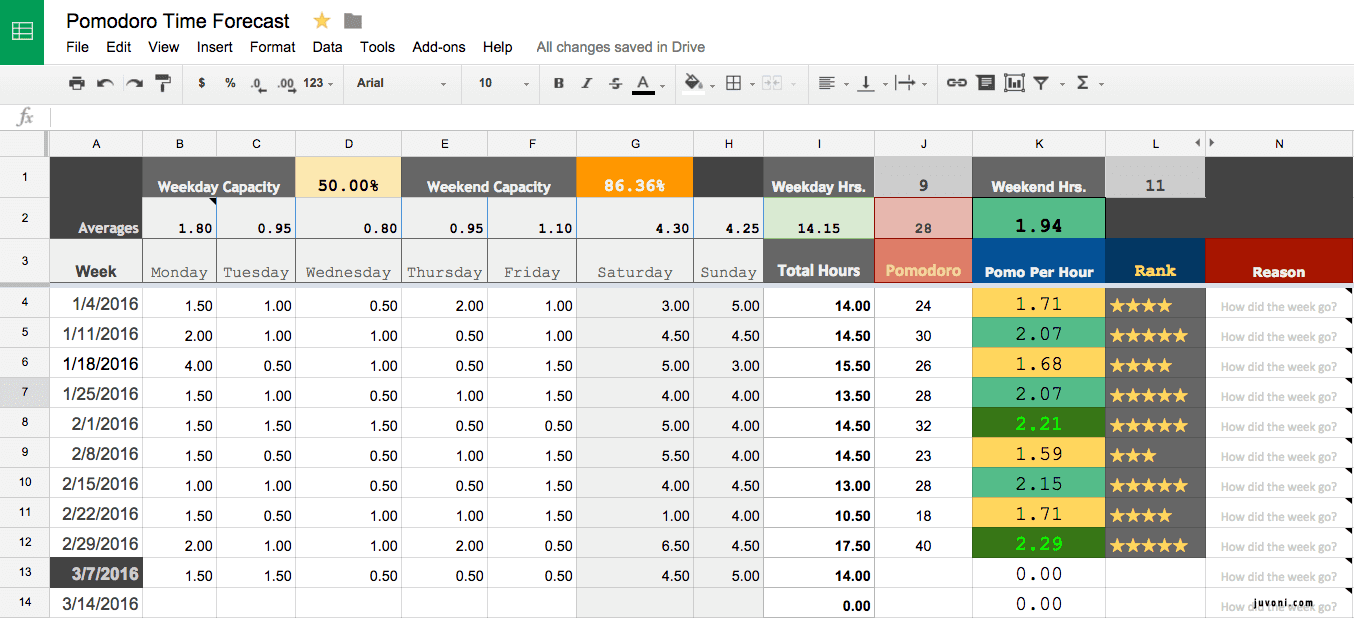
What I've Learned Using Pomodoro Time Forecasting
1. It's difficult to predict free time with too many commitments
When you have many outside commitments that are less structured than meetings or you're uncertain when they could take place, it's difficult to estimate your free time. I've learned to be conservative in those situations and only estimate the bare minimum of what I can do, I use 30 minutes as my minimum and plan to have some buffer at the time.
Over time, I continue to increase until I find my optimal baseline estimate and use 30-minute increments.
2. You become more aware of how short time is
Through estimating your time, you can start to spot patterns and inefficiencies. You build the awareness of matching the right work with the right amount of time. The benefits also lead to goal setting where you can plan more realistically based on how much time you can put into the goal.
3. Being efficient with your time isn't enough you need to allocate your time to the right things
Productivity is good, but if you are working efficiently on the wrong things, you're still wasting time. Be more effective and prioritizing the right things. I had weekly and monthly planning session to check my progress and align my goals with my priorities.
4. Estimating Time is a habit in of itself
Because I have to forecast out the time in advance, I have to create a routine for consistently estimating my time. Sunday seems to be the best day for me as I can look forward to what I have coming up in the week.
5. You value your time more and become more defensive
Since you become more aware that time is scarce, you attach more value to it. You begin to measure more activities to see if they are worth your time. You prioritize more and feel more confident to say no to things that don't excite your or not aligned with your priorities and values.
6. Those close to you don't like to be scheduled
The concept of forecasting out your own personal time back to yourself may seem odd and intense. It's strange to family and friends. It is a very formal activity and can be perceived as being the very transactional if you timebox people. View your productivity as a way to free up more time to spend focused in the now and with those you care about.
7. You need to hold yourself accountable
When you estimate the time you want to invest in yourself for the week, you need to make sure you hold yourself accountable to starting and finishing the work you set out towards. Find a way to incentivize yourself, preferably with internal motivators backed by real purpose.
8. Prevent burnout and manage your energy
Through tracking and estimating time, I became more aware of how much time it would take to get something done. I knew which weeks I needed to increase or decrease hours on to get work in and would stay within my capacity. I could plan for break time and plan for some extra hard work.
9. It's easy to isolate yourself with aggressive time forecasts
After a while, I built up strong discipline, and it was too easy for me to say no too much and stay in my comfort zone. I enjoyed having my alone time and studying.
In the long run, that isn't good for my interpersonal growth, and I become more aware of when I'm too aggressive with my time forecasting and being too selfish with my time.
10. Share Your Time, Do More Good
Time is all we have, but there is so much more we can give. Productivity is a tool to enable one to live more fully in a day. The living part is the big piece, what will you do with your time on this earth. Build the capacity to do more good. Whatever that means to you, you create the meaning.
#pomodoro #productivity“Investing in yourself is the best investment you will ever make. It will not only improve your life, it will improve the lives of all those around you.” - Robin S. Sharma, The Monk Who Sold His Ferrari: A Fable About Fulfilling Your Dreams & Reaching Your Destiny